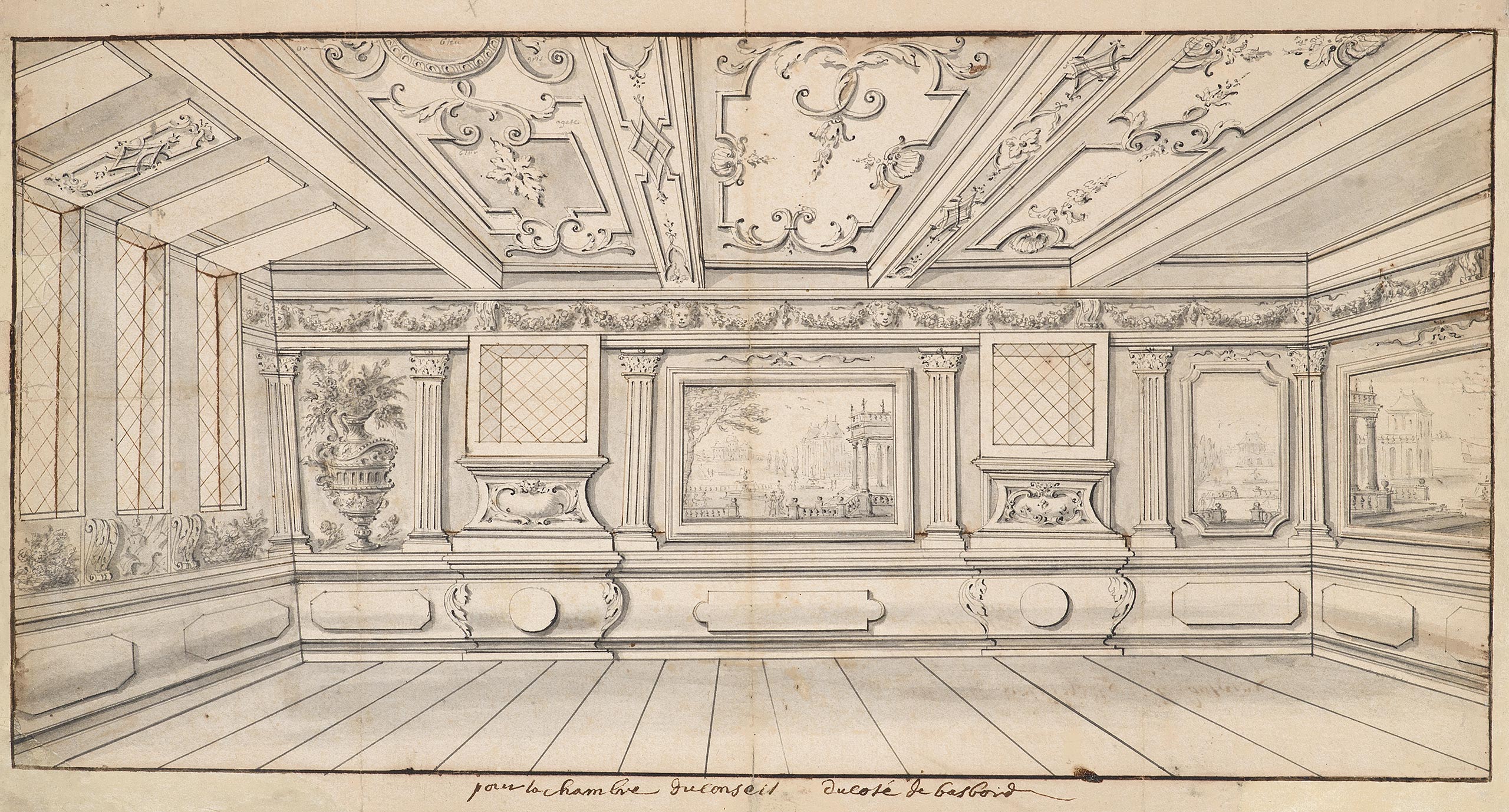
de La Rose
Jean-Baptiste
Marseille circa 1612 — Toulon 1687
Study for the Decor of a Council Chamber on a Royal Ship
Pen, grey and brown ink, grey wash. Framing line in pen and brown ink. Inscribed pour la chambre du conseil du côté de basbord lower centre. Inscribed veu dufresnoy/ veu le bailli de bellefontaine Lasions ( ?) / a monsieur le con[seiller ?] pour Recevoir les offres / an illegible signature / delarose lower left on the verso.
225 x 409 mm (8 7/8 x 16 1/8 in.)
One of the earliest French naval painters, Jean-Baptise de La Rose is also the one whose work is least known, although his early biographers1 describe the admiration of Mazarin when he visited La Rose’s studio in Marseille in 1660, and then later that of the Marquis de Marigny, who is said to have advised Vernet to study “the exactness of the proportions of the vessels and the establishment of their agrés” on the paintings of the Toulon master.2 His career as a ship decorator began to flourish in the 1660s, with the resumption of shipbuilding when Louis XIV reached the age of majority. In 1663, La Rose collaborated with the sculptor Nicolas Levray on several ship decorations, including those for the Thérèse and the Saint-Philippe.3 In 1667, he submitted a number of projects to the competition organised to decorate the Royal-Louis,4 but the commission was eventually awarded to Charles Le Brun. He was nevertheless appointed “master painter in the care of the King”, like Pierre Puget, with whom he sometimes collaborated. Jean-Baptiste de La Rose was a drawing professor at the Toulon art school and painted numerous seascapes for local amateurs, of which almost nothing remains.
As with his paintings, not many of his drawings have survived: the Musée du Louvre has the Projet de décoration d’un salon (Project for the decoration of a Salon ; RF 2379), very similar to ours, and the Projet de frise décorative sculptée (Project for a sculpted decorative frieze ; RF 2378) for the Royal-Louis – both from the Chennevières collection. A large project for the exterior decoration of a royal galley is in the Orléans Musée des Beaux- Arts while the Marseille Musée des Beaux-Arts keeps a study of a vessel. Studies of wood panelling are held in private collections.5
Our drawing is very similar to RF 2379 in the Louvre, in terms of format, technique and decoration. Both provide rare evidence of the luxurious interior decoration of a ship of the royal fleet: large paintings, wood panelling, painted ornaments on the ceiling. However, the drawing in the Louvre shows a homogenous, symmetrical decoration, whereas ours contains different proposals on either side of the two central motifs on the main wall and the ceiling. It is therefore a project designed to offer several options and help the patron to choose. In both drawings, the ornamental vocabulary is similar: landscape paintings, bouquets, a garland and mascarons in the upper part, interlaces used on the mantelpiece in the Louvre drawing, on the interior shutter of the window in ours. These two drawings may be designs for two different rooms of the same ship. The inscriptions on the verso of ours seem to suggest the visa of Jacques Auguste Maynard, known as the Bailli de Bellefontaine (1646-1720), who joined the Royal Navy in 1673 and, during Jean-Baptiste de La Rose’s lifetime, commissioned Le Trident, L’Invincible and L’Aquilon. It may therefore be necessary to look in this direction to find out which ship these decorations were intended for.
- The writings of Father Bougerel (1680-1753), summarised by Porte and reported by Dr. Pons in Archives de l’art français (January 1858, volume VI), are a first study, enriched by that of C. Ginoux in 1887 in Les écoles d’art à Toulon 1640-1887. Jean-Baptiste de la Rose painter to the king. La Bastide de Pierre Puget, Paris, E. Plon, 1887.
- Ginoux, op cit., p. 22.
- V. Brun, “Notice sur la sculpture navale et chronologique des maîtres sculpteurs du port de Toulon”, Bulletin de l’Académie du Var, Toulon, 1861, volumes 28 and 29, pp. 69-155, see p. 146.
- M. Margry, Archives de l’art français, IV, 1855-1856, p. 225-310.
- P. Rosenberg, entry in La peinture en Provence au XVIIe siècle, Marseille, musée des Beaux-arts, 1978, n° 116-119, four red chalk ornemental drawings.

